Adolphe, Edgar, Monsieur (British Silhouette..., Section 2, 1978)
See also sections Three and Six
Recorded by Jackson (The History of Silhouettes). Although, on his trade labels, Adolphe calls himself a 'miniature painter', and did in fact produce profile miniatures in colour (a poor example is illustrated in Section Six), he is not listed by Foskett. Mr J. N. Allen, of the Brighton Public Libraries, has traced the artist's Christian name (Edgar), has established that he was married and that his wife's name was Eloise, and has traced entries in contemporary directories which yield further information.
Of Adolphe's life before c. 1838, we know only what the wording of his trade labels and the appearance of known silhouettes tell us. The earliest known example of his work appears to have been taken in c. 1832. It is backed by trade label which tells us that Adolphe was 'Miniature Painter, and Profilist, to Louis Philippe, King of the French.' Louis Philippe was King of France 1830-48. Since Adolphe presumably received this Royal appointment after the King's accession, it is surprising that in fact he appears to have left his own country for England in c.1832, to judge from the style and appearance of silhouettes which he is known to have taken in England. Adolphe has always been associated only with Brighton, but on present evidence it seems that he must have been working (and probably travelling) in England for some years before he settled in that town. This is suggested by his first two trade labels. Neither bear an address, and both are printed on white paper, not on the yellow paper which for some reason was normally used for this purpose by profilists in Brighton and on which Adolphe's Trade Label No. 3 (used as late as 1840) was printed. One signed silhouette (showing an apparently fashionable young woman) cannot have been taken much later than 1833.
645
One of the most often illustrated and best known profiles by Adolphe is of George IV, who died in 1830; this profile was probably taken posthumously (possibly from an oil painting or a print) after Adolphe had arrived in Brighton, and the artist probably sold it as a 'stock' profile in the town where the late king was especially remembered. Since Adolphe was first listed in a local directory in 1839, we can assume that he settled in Brighton in 1838. His name first appears (in Leppard's Directory) with an address at 113 St James's Street. A well known example of Adolphe's work which bears his trade label (No. 3) with this address is his silhouette of Lady John Townshend (National Portrait Gallery); a silhouette formerly in the Coke collection (sold by Sotheby and Company, London, in July 1931) also bore this label.
By 1845 (the year of the last directory entry) he had moved to 4 East Street, where his wife Eloise managed a tobacconist's shop. The profile miniature illustrated in Section Six is dated 16 August 1846, and this is the latest known dated example. Whether, soon after this date, Adolphe moved to another part of England, or left the country to return to his native France, is unknown.
Adolphe painted on card and in a variety of styles. One early profile (illustrated) is indifferently painted in plain black, except for a line or two to show the shape of the man's cravat and collar.
644
Adolphe's most individual style is shown in the profile of Miss E. Rowe, which is painted in a mixture of green, grey body colour and gold paint, applied with reasonable skill, though the mixture of grey and green has a streaky appearance which shows even on the face of the portrait.
645
Where the gold paint is applied (on the hair, and in the details of dress) the work is neat and accurate. Jackson illustrates another example, apparently from the late 1830s, which is painted in this style.
Towards the end of the 1830s and during the 1840s, Adolphe painted his subjects against a dark blue-grey background, with costume detail shown either in gum arabic (applied in sufficiently thick lines to show a certain amount of peeling at the present time) or in gold. On some profiles of men, only the hair is painted in gold. Adolphe did not use Chinese white when painting men's cravats, which he indicated with lines of thinned black pigment.
In a group of children's portrait busts (c. 1845-6)illustrated in Chapter Nine, Adolphe used a deep sepia ground with gum arabic to show detail.
251
Much of Adolphe's work shows a line of shadow, composed of thinned black pigment, below the bust line termination, which in a number of instances bore his signature.
Some of the illustrated examples have been cut to fit papier mâché frames. Most of the originals were probably rectangular; most early examples were probably housed in plain giltwood frames, later examples in rosewood.
647
Previous authorities have stated that Adolphe offered full-length work and conversation pieces. There is in the Elliott Levy collection a full length silhouette of a boy, painted in black, with hat, socks, collar and gloves in white. Aged about three, the boy is shown wearing a rosette on the left of his hat. The background is a planked floor. The silhouette is signed 'Adolphe' on the front, and bears Trade Label No. 3.
Five trade labels are recorded. Nos 1 and 2 (illustrated) were used by Adolphe before he settled in Brighton; both are small and bear no address. Trade Label No. 1, which refers to Louis-Philippe, may have been Adolphe's first printed label. Trade Label No. 2 appears to have been used c. 1836-38.
Trade Label No. 3, used at 113 St James's Street, Brighton, in 1840, is printed on bright yellow paper. The wording (quoted from an example in the D. S. Patton collection) is as follows:
The Origin of Profiles
‘Twas love,’twas all-inspiring love, ‘tis said,
Directed first a female hand to trace,
In some Corinthian hall, her lover’s face
As once it fell an evanescent shade
Upon the marble wall;aye, she pourtray’d
Each linament (sic) so true, each turn and grace,
It seemed as through some spell had charmed the place,
And stamped the image there; the enraptured maid
Enamoured gazed, bewildered to behold
The work herself had done;yet she was there
The able enchantress then. Oh!who’s that’s told
This classic tale, would not a SHADE revere?
And each to each fond interchanges make,
For love, affection, or for Friendship’s sake.
SKETCHED BY
MONS. ADOLPHE,
Portrait, Animal, Miniature, and Profile
PAINTER
113, St. James's Street, Brighton
Trade Label No. 4, printed on pink paper, is rectangular (11/2 x 21/2 in.). On the example which I have seen (previously unrecorded; on the reverse of a silhouette of a boy in the Elliott Levy collection) the address has been obliterated. This suggests that Adolphe used it (after Trade Label No. 3) both at 113 St. James's Street, and later at 4 East Street, Brighton, before printing new labels for use at that address. The text reads as follows:
PAINTED BY
ADOLPHE
PORTRAIT, ANIMAL, MINIATURE
AND
PROFILE-PAINTER
113, St. James' Street
BRIGHTON.
Likenesses retouched copied
with accuracy.
Frames made to any size or pattern
on the shortest notice.
Trade Label No. 5 is a label referred to by Mrs Jackson. who writes that it was printed on grey paper and used at 4 East Street, Brighton; she writes that it was used on the back of a family group.
Relating Adolphe's production to this series of trade labels one may surmise that silhouettes bearing No's 1 or 2 date from the period up to 1838, those bearing No.3 from c. 1838-44, those bearing No.4 from 1844-45, and those bearing No.5 from 1845 onwards.
Adolphe signed much of his work, sometimes even when a trade label was also used. Sometimes the signature is in capital letters, sometimes in script in a 'shadow line' beneath the bust. On the portrait miniature illustrated in Section Six the name is in cursive writing, sloping backwards, with a swirling line from the final 'e' sweeping round the name to form an oval. The surname Adolphe alone has also been seen.
The 'shadow line' signatures are placed much as were those of other artists who used this method signature, for example John Dixon and J. Holnies. Adolphe was said by Jackson to have described his method as 'manographing', but it is not clear whether Jackson was referring to this method of signing, or to his general method of painting.
Ills. 251, 644-651, 978
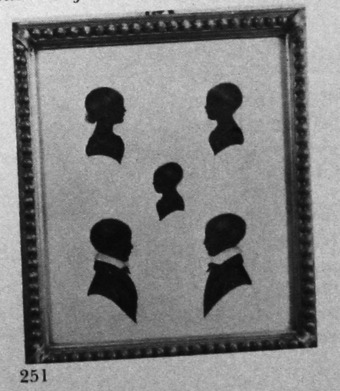
Unknown family of young children
Silhouette by ‘Monsieur’ Edgar Adolphe, painted c. 1845-46, probably at 4 East Street, Brighton.
costume dating points
The girl at top left (aged about six)
She is old enough to wear her hair fairly long at the back.
She wears the 1840s version of the young girl’s thin muslin dress (described in the text).
The two boys (?) at top right and centre (aged about three years and about fifteen months respectively). These two children (probably boys, to judge from their features) both wear the same type of dress as the girl at top left.
The two boys below (left, aged about eight; right, aged about ten).
It is these boys’ costume which enables one to date this silhouette. Both wear their hair combed away from the back of the head towards the front and sides, as do their younger brothers, and both wear collars smaller than the collar shown in 257 (c. 1843) and similar in size to that shown in 258 (1847).
Collection of the late J. C. Woodiwiss
SECTION TWO
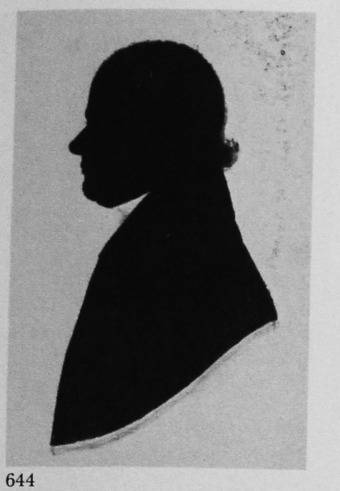
Unknown man
Silhouette painted on card
c. 1832
3¾ x 2¾in./96 x 70mm.
Trade Label No. 1
Frame: black reeded wood
This silhouette is difficult to date because of the lack of detail.
Author’s collection
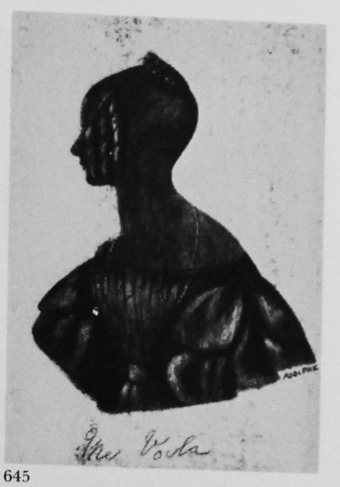
Miss E. Rowe
Silhouette painted on card
c. 1832-33
4¾ x 4in./121 x 102mm.
Frame: square, giltwood
Signed ‘Adolphe’ below the sleeve on the right; the words ‘me voilà’ are pencilled below.
Author’s collection
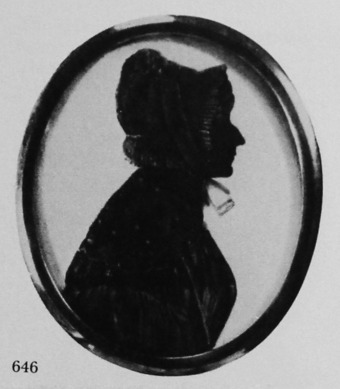
Unknown woman
Silhouette painted on card in gold, with detail in gum Arabic, against a dark grey background
c. 1836-38
3½ x 2½in./90 x 64mm.
Trade Label No. 2
Frame: papier mâché
The hanger on the frame (with rope, shell and anchor motives) suggests either that the sitter was the wife of a high-ranking naval officer, or that the silhouette has been reframed.
Graham Robinson collection
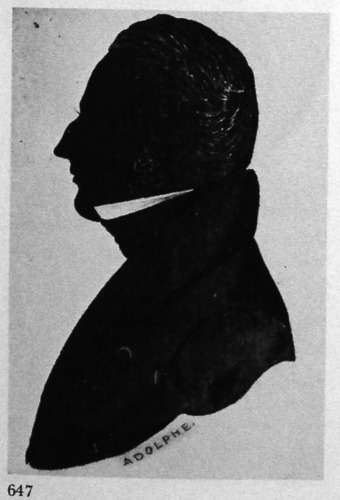
Unknown man
Silhouette painted on card, with detail in gum Arabic and gold, against a dark blue-grey background
c. 1836-39
3½ x 2¼in./90 x 58mm.
the sitter’s hair is shown with fine strokes of gold paint. Signed ‘ADOLPHE’ below the centre of the unusual bust-line. The card on which the silhouette is painted has been cut down.
Author’s collection
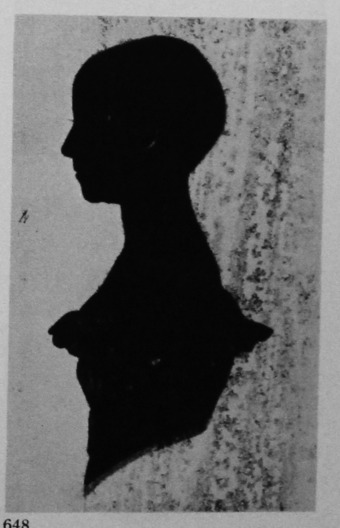
Unknown girl
Silhouette painted on card, in gold and gum Arabic, against a dark-grey background
c. 1840
3¾ x 2¾in./96 x 70mm.
Trade Label No. 3
D. S. Patton collection
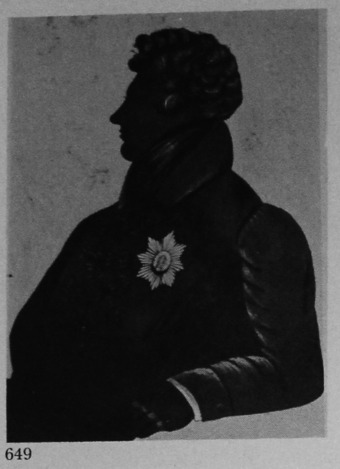
George IV
Silhouette painted on card, with detail in gold, against a dark-grey background
Probably painted posthumously, after a portrait in oils. The king’s hair and jewels are painted in gold.
From E. Nevill Jackson, ‘The History of Silhouettes’ (1911), by courtesy of the ‘Connoisseur’
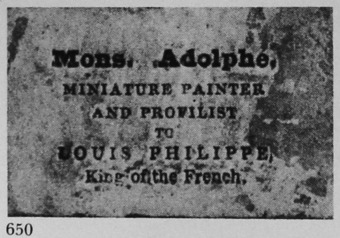
Trade Label No. 1 of ‘Monsieur’ Edgar Adolphe.
Author’s collection
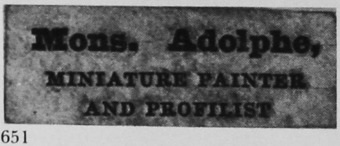
Trade Label No. 2 of ‘Monsieur’ Edgar Adolphe.
Graham Robinson collection
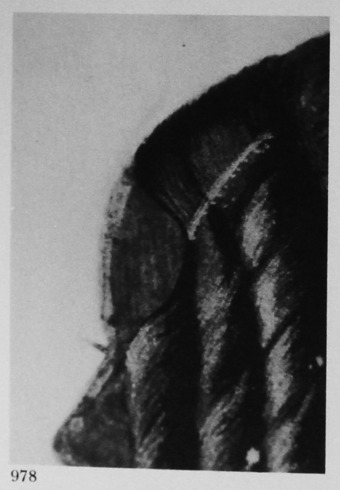
Woman’s air, and part of her face. Detail from a silhouette by E. Adolphe, painted in his characteristic mixture of green, grey and gold. Note the streaky effect on the face also. (645)
